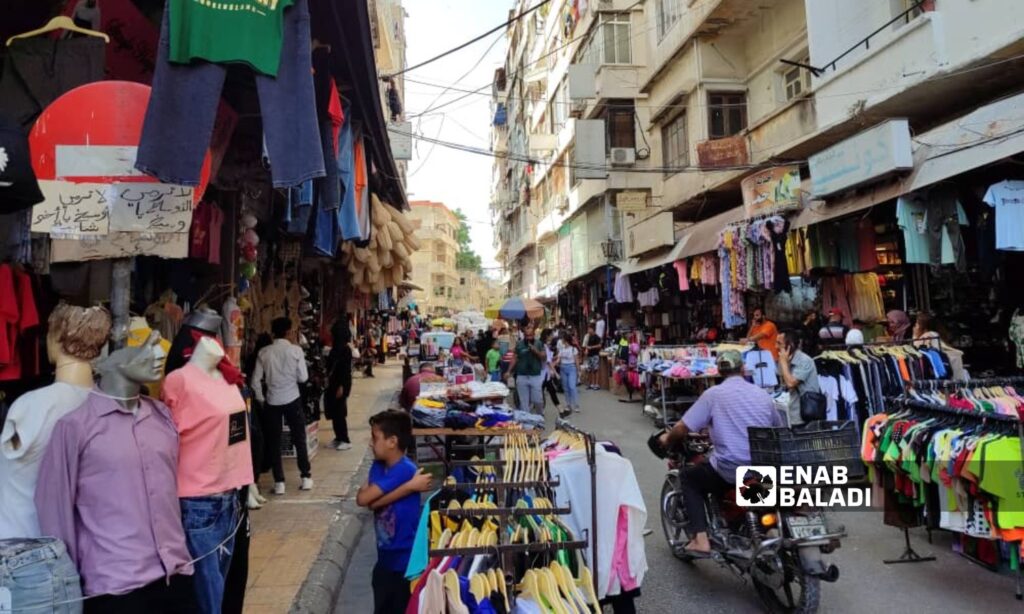The owner of a traditional sweets shop on al-Qouatli Street in Latakia was not satisfied with the market movement, describing it as “dead,” hoping it would improve by noon on Friday, June 14, after high school exams concluded.
The shop owner did not sell more than 25% of the total quantities he produced, which usually sold out in the last two days before the Eid holiday, as happened during the last Eid al-Fitr when he sold 75% of his production.
Nearby, a chocolate, candy, and Turkish delight seller was weighing small quantities not exceeding half a kilogram or less of each type since customers were only asking for a mix enough for one serving platter.
The government grant announced at 300,000 Syrian pounds could not stimulate the market; the price of a kilogram of popular candy reaches at least 40,000 Syrian pounds, while the price of a kilogram of date maamoul cookies with vegetable shortening ranges from 40,000 to 60,000 pounds, nut-filled maamoul cookies from 70,000 to 100,000 pounds, and petit four from 40,000 to 70,000 pounds.
When using animal shortening, prices more than double: a kilogram of date maamoul cookies ranges between 120,000 and 200,000 pounds, nut-filled maamoul cookies between 220,000 and 300,000 pounds, and pistachio-filled maamoul cookies between 300,000 and 400,000 pounds.
Traditional Arabic sweets tell another story, with no kilogram selling for less than 300,000 pounds even at stores known for their low prices, while prices at renowned stores like Al-Bahr, Aboullaban, and Mhana are roughly 50% higher.
“I don’t even think about visiting the market”
Iman (43) does not even consider visiting the market since the grant she received, and could not collect until noon on Thursday due to ATM queues, would go entirely to the grocery store owner to pay off her debt, which exceeds a million pounds.
The 40-year-old woman has been exhausted by the expenses of private lessons for her son in middle school, incurring large and numerous debts she does not know how to manage. Therefore, she has no options during Eid: no clothing, no sweets, not even different food from other days.
The minimum government salary in regime-controlled areas is about 279,000 pounds, while the average cost of living for a Syrian family of five has risen to about 12.5 million pounds per month, with the minimum reaching 7.8 million pounds.
“Clothing prices are through the roof”
The price for a complete outfit for a man or a woman in mid-range stores is no less than a million pounds and reaches approximately two million pounds in large stores and clothing agencies. These prices are unaffordable for most families who resort to bazaars like al-Anayah, al-Qouatli, and the covered market in Latakia.
Prices in typical markets are no longer low and satisfactory for customers. In al-Anayah Market, Latakia’s cheapest markets, the price of an outfit for a baby under one year starts at 75,000 pounds, another is priced at 90,000 pounds, and for older children, it can reach 300,000 pounds.
The market commercial movement was slow, and several sellers agreed that they had not sold anything worth mentioning yet.
Lina (45) said she would not have planned to buy any clothes for her three children, had it not been for a remittance from her husband’s sister living in the Netherlands, which they were informed about two days ago.
The remittance amounted to 300 dollars (about 4.4 million pounds), and despite being a considerable amount in Syrian pounds, it would not suffice for all Eid requirements and the usual outings. Therefore, she decided to buy light clothing for her children. For instance, her daughter needs a dress and already has shoes, her son needs shoes and a shirt as he already has jeans, and as for herself, she will settle for a summer coat and black shoes, she said.
There is no way to make sweets at home this Eid due to the domestic gas crisis and the long wait for gas delivery, which exceeds 70 days. Thus, buying ready-made sweets with vegetable shortening will be the best option. Like most of her neighbors, she will only buy one and a half kilograms of each type, such as maamoul cookies filled with dates and nuts, and petit four.
Several sellers in al-Qouatli and al-Anayah markets agreed that the market’s movement, though slight during the last Eid al-Fitr, was better than this Eid. They added that prices have increased slightly compared to last Eid by no more than 2000 to 5000 pounds per kilogram, whereas it’s impossible to compare clothing prices since summer clothes are cheaper than winter ones.

